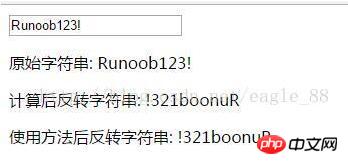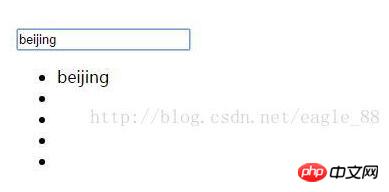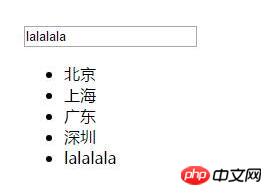Detailed explanation of usage of computed, filter, get, set
This time I will bring you a detailed explanation of the usage of computed, filter, get, and set. What are the precautions when using computed, filter, get, and set. The following is a practical case, let's take a look.
1. The computed method of vue.js:
handles complex logic, based on dependency caching, and will re-value when dependencies change. . The same effect can be achieved using methods, but methods will be re-invoked and executed when re-rendering. Computed is better than methods in terms of performance. Methods can be used when caching is not needed.
Example 1: computed and methods implement flippingString##
<template>
<p>
<input v-model="message">
<p>原始字符串: {{ message }}</p>
<p>计算后反转字符串: {{ reversedMessage }}</p>
<p>使用方法后反转字符串: {{ reversedMessage2() }}</p>
</p>
</template>
<script>
export default {
data () {
return {
message: 'Runoob123!'
}
},
computed: {
// 计算属性的 getter
reversedMessage: function () {
// `this` 指向 vm 实例
return this.message.split('').reverse().join('')
}
},
methods: {
reversedMessage2: function () {
return this.message.split('').reverse().join('')
}
}
}
</script>
Example 2: Computed get() and set() usage
<template>
<p>
<select v-model="site">
<option value="Google http://www.google.com">Google http://www.google.com</option>
<option value="baidu http://www.baidu.co">baidu http://www.baidu.com</option>
<option value="网易 http://www.163.com">网易 http://www.163.com</option>
</select>
<p>name:{{name}}</p>
<p>url:{{url}}</p>
</p>
</template>
<script>
export default {
data () {
return {
name: 'Google',
url: 'http://www.google.com'
}
},
computed: {
site: {
// getter
get: function () {
return this.name + ' ' + this.url
},
// setter
set: function (newValue) {
let names = newValue.split(' ')
this.name = names[0]
this.url = names[names.length - 1]
}
}
}
}
</script>
2. filterfilter method of vue.js:
The filter will return data A simple function that performs processing and returns the processing result. However, it was removed in the vue2.0 version. The alternative is to write the function in methods.Instance:
<template>
<p>
<input v-model="filterText"/>
<ul>
<li v-for="item in obj">
<span>{{myfilter(item.label)}}</span>
</li>
</ul>
</p>
</template>
<script>
export default {
data () {
return {
obj: [
{value: 0, label: 'beijing'},
{value: 1, label: 'shanghai'},
{value: 2, label: 'guangdong'},
{value: 3, label: 'zhejiang'},
{value: 4, label: 'jiangshu'}
],
filterText: ''
}
},
methods: {
myfilter (value) {
if (value.indexOf(this.filterText) > -1) {
return value
}
}
}
}
</script>
3, vue.js The get and set methods:
The data attribute in vue can respond to data changes. Internally, the data attribute is converted into getter/setter. In vue2.0, get() and set( ) is used in computed properties and has been covered in the computed example above. In addition, vm.$set(object, key, value) inherited from vue1.0 is used to dynamically monitor data elements. After the instance is created, the array attribute is added and a response is available. method implementation.
<template>
<p>
<input v-model="opt" @blur="add()"/>
<ul>
<li v-for="item in arr">
{{ item }}
</li>
</ul>
</p>
</template>
<script>
export default {
data () {
return {
arr: [ '北京', '上海', '广东', '深圳' ],
opt: ''
}
},
methods: {
add () {
this.$set(this.arr, this.arr.length, this.opt)
}
}
}
</script>
How to update the array with $set in vue.js
How to move the array in vue.js Position and update
Detailed graphic and text explanation of using vue2-highcharts in Vue
The above is the detailed content of Detailed explanation of usage of computed, filter, get, set. For more information, please follow other related articles on the PHP Chinese website!

Hot AI Tools

Undresser.AI Undress
AI-powered app for creating realistic nude photos

AI Clothes Remover
Online AI tool for removing clothes from photos.

Undress AI Tool
Undress images for free

Clothoff.io
AI clothes remover

Video Face Swap
Swap faces in any video effortlessly with our completely free AI face swap tool!

Hot Article

Hot Tools

Notepad++7.3.1
Easy-to-use and free code editor

SublimeText3 Chinese version
Chinese version, very easy to use

Zend Studio 13.0.1
Powerful PHP integrated development environment

Dreamweaver CS6
Visual web development tools

SublimeText3 Mac version
God-level code editing software (SublimeText3)

Hot Topics
 Detailed explanation of the mode function in C++
Nov 18, 2023 pm 03:08 PM
Detailed explanation of the mode function in C++
Nov 18, 2023 pm 03:08 PM
Detailed explanation of the mode function in C++ In statistics, the mode refers to the value that appears most frequently in a set of data. In C++ language, we can find the mode in any set of data by writing a mode function. The mode function can be implemented in many different ways, two of the commonly used methods will be introduced in detail below. The first method is to use a hash table to count the number of occurrences of each number. First, we need to define a hash table with each number as the key and the number of occurrences as the value. Then, for a given data set, we run
 Detailed explanation of obtaining administrator rights in Win11
Mar 08, 2024 pm 03:06 PM
Detailed explanation of obtaining administrator rights in Win11
Mar 08, 2024 pm 03:06 PM
Windows operating system is one of the most popular operating systems in the world, and its new version Win11 has attracted much attention. In the Win11 system, obtaining administrator rights is an important operation. Administrator rights allow users to perform more operations and settings on the system. This article will introduce in detail how to obtain administrator permissions in Win11 system and how to effectively manage permissions. In the Win11 system, administrator rights are divided into two types: local administrator and domain administrator. A local administrator has full administrative rights to the local computer
 Detailed explanation of division operation in Oracle SQL
Mar 10, 2024 am 09:51 AM
Detailed explanation of division operation in Oracle SQL
Mar 10, 2024 am 09:51 AM
Detailed explanation of division operation in OracleSQL In OracleSQL, division operation is a common and important mathematical operation, used to calculate the result of dividing two numbers. Division is often used in database queries, so understanding the division operation and its usage in OracleSQL is one of the essential skills for database developers. This article will discuss the relevant knowledge of division operations in OracleSQL in detail and provide specific code examples for readers' reference. 1. Division operation in OracleSQL
 Detailed explanation of remainder function in C++
Nov 18, 2023 pm 02:41 PM
Detailed explanation of remainder function in C++
Nov 18, 2023 pm 02:41 PM
Detailed explanation of the remainder function in C++ In C++, the remainder operator (%) is used to calculate the remainder of the division of two numbers. It is a binary operator whose operands can be any integer type (including char, short, int, long, etc.) or a floating-point number type (such as float, double). The remainder operator returns a result with the same sign as the dividend. For example, for the remainder operation of integers, we can use the following code to implement: inta=10;intb=3;
 Detailed explanation of the usage of Vue.nextTick function and its application in asynchronous updates
Jul 26, 2023 am 08:57 AM
Detailed explanation of the usage of Vue.nextTick function and its application in asynchronous updates
Jul 26, 2023 am 08:57 AM
Detailed explanation of the usage of Vue.nextTick function and its application in asynchronous updates. In Vue development, we often encounter situations where data needs to be updated asynchronously. For example, data needs to be updated immediately after modifying the DOM or related operations need to be performed immediately after the data is updated. The .nextTick function provided by Vue emerged to solve this type of problem. This article will introduce the usage of the Vue.nextTick function in detail, and combine it with code examples to illustrate its application in asynchronous updates. 1. Vue.nex
 Detailed explanation of the linux system call system() function
Feb 22, 2024 pm 08:21 PM
Detailed explanation of the linux system call system() function
Feb 22, 2024 pm 08:21 PM
Detailed explanation of Linux system call system() function System call is a very important part of the Linux operating system. It provides a way to interact with the system kernel. Among them, the system() function is one of the commonly used system call functions. This article will introduce the use of the system() function in detail and provide corresponding code examples. Basic Concepts of System Calls System calls are a way for user programs to interact with the operating system kernel. User programs request the operating system by calling system call functions
 Detailed explanation of the role and usage of PHP modulo operator
Mar 19, 2024 pm 04:33 PM
Detailed explanation of the role and usage of PHP modulo operator
Mar 19, 2024 pm 04:33 PM
The modulo operator (%) in PHP is used to obtain the remainder of the division of two numbers. In this article, we will discuss the role and usage of the modulo operator in detail, and provide specific code examples to help readers better understand. 1. The role of the modulo operator In mathematics, when we divide an integer by another integer, we get a quotient and a remainder. For example, when we divide 10 by 3, the quotient is 3 and the remainder is 1. The modulo operator is used to obtain this remainder. 2. Usage of the modulo operator In PHP, use the % symbol to represent the modulus
 Detailed explanation of Linux curl command
Feb 21, 2024 pm 10:33 PM
Detailed explanation of Linux curl command
Feb 21, 2024 pm 10:33 PM
Detailed explanation of Linux's curl command Summary: curl is a powerful command line tool used for data communication with the server. This article will introduce the basic usage of the curl command and provide actual code examples to help readers better understand and apply the command. 1. What is curl? curl is a command line tool used to send and receive various network requests. It supports multiple protocols, such as HTTP, FTP, TELNET, etc., and provides rich functions, such as file upload, file download, data transmission, proxy






